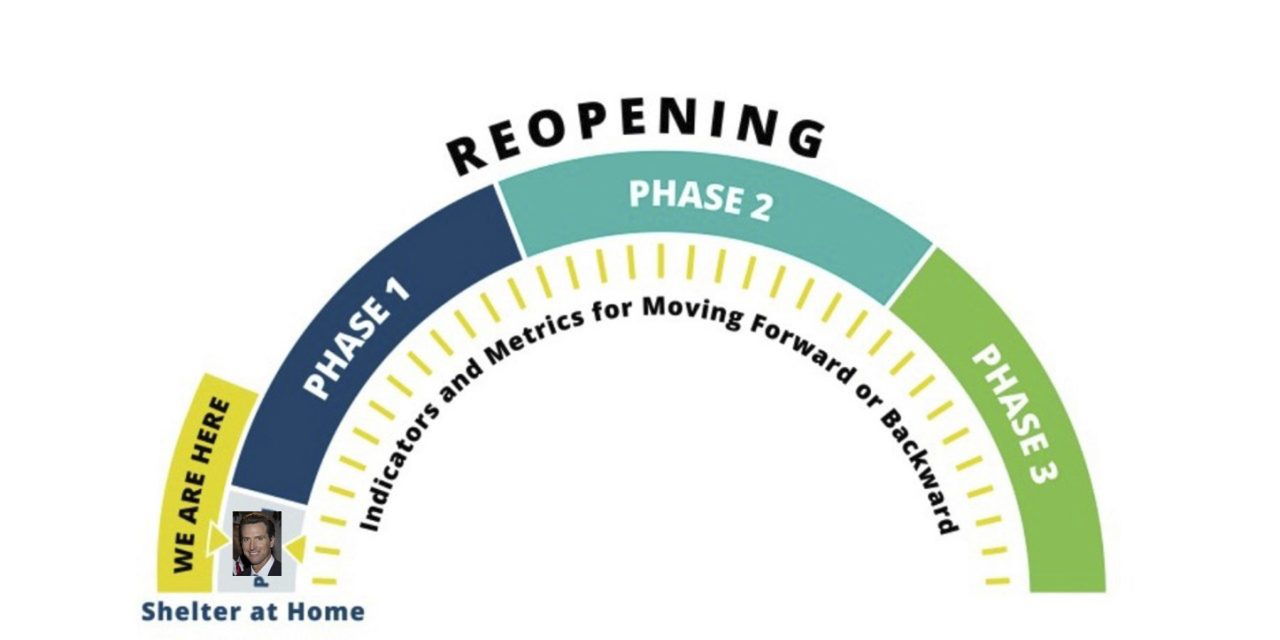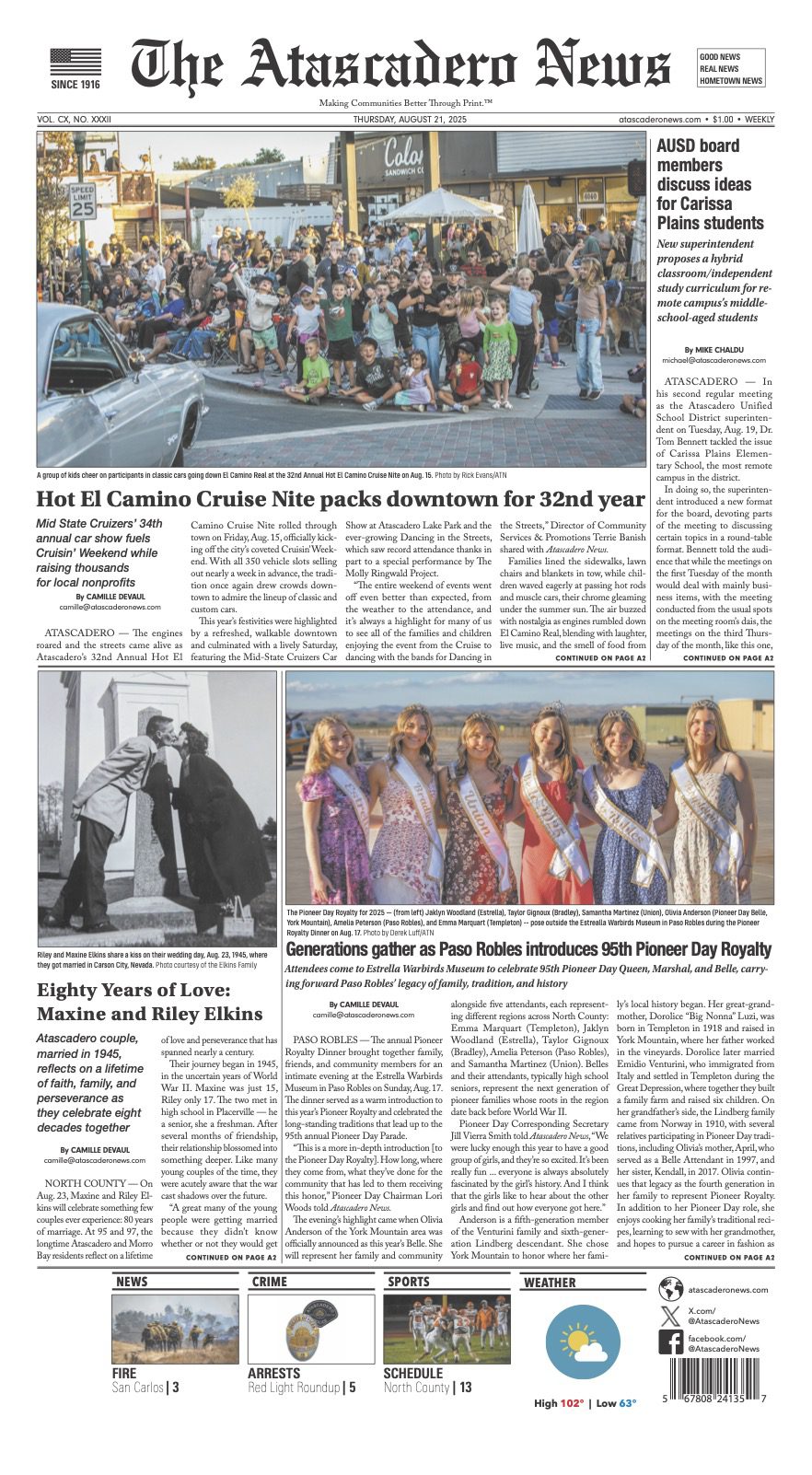SLO County relinquishes local control to the State
“Open, open, open.” The spectre of the now-defunct Mervyn’s ad spot stirs an ironic echo of both a time of in-person shopping and also a surging anticipation of California commerce to awake from a spring suppression.
Longtime residents of San Luis Obispo County remember the Madonna Plaza as the go-to for shopping. Today, the SLO Ralphs grocery store inhabits the building where Mervyn’s stood — open, as one of the few businesses allowed to remain open by the SLO County shelter-at-home order.
Other businesses in the shopping center — along with thousands of retail businesses in the county — begin a modified opening according to the latest guidelines from the State, instead of what was expected to be a green light of the SLO County SMART Guide.
“A week ago, we were expecting the governor to say ‘execute your plan,’” Horton said. “It was thoughtful, very deliberate, it was responsible, and there was tremendous community input in that plan.”
However, the speed the county was planning to reopen was reduced by the State’s pace car known as the “Resilience Roadmap” that now governs all commerce in California.
On May 8, the State lifted restrictions on some retail in California with modifications in accordance with health standards and measures to continue suppression of the spread of COVID-19.
SLO County had presented the START Guide in anticipation of state authorization to self-manage the reopening of the local community and economy. For the time being, the effort was for naught and the START Guide comes to a stop.
At Friday’s public briefing, SLO County Emergency Services Directory Wade Horton announced his disappointment about the plan’s rejection by the state.
“Our focus has been to ‘bend the curve’ and create the health capacity necessary,” Horton said. “We’ve also focused on safely opening our community and society.”
The START Guide represented a collaborative effort by county stakeholders and elected officials to provide a reopening framework specific to SLO County, but ultimately needed the State’s approval.
“The governor has not given us the ability to move forward with our guide,” Horton said, “and has since outlined his own roadmap for reopening, which is available online at covid19.ca.gov.”
Horton wore dejection on his sleeve as he reported information as related from the state and applicable to the county.
“The County has not been granted local control to implement our START Guide,” Horton said. “We remain under State control and subject to the governor’s Resilience Road Map. The governor will enforce his road map through State regulatory bodies.”
Without state approval the START Guide is officially dead.
“I am disappointed by this outcome,” Horton said. “We had great hope, alongside you, that we would be moving forward to reopen more of our workspaces and community spaces. The governor’s road map is still being updated, but based on what is published, it will be a longer path to reopening and it will delay the reopening of certain businesses along different timelines.”
One of the most clamored-for industry sectors in SLO County has been salons and beauty shops, which was targeted by California Governor Gavin Newsom as an early source of community spread of COVID-19.
Horton continued to be the bearer of bad news.
“Churches, salons, wineries, and barbershops will not be opening up in the governor’s stage two at this time,” Horton said, before shifting to couched optimism. “We will continue to advocate and make the case to the state for a safe, reasonable, and responsible path for reopening.”
Under the state plan, curbside retail is considered a low-risk sector, and the planning and logistics industries that support retail are also authorized to begin operation.
While the state road map supersedes all other reopening plans in foreseeable future, it does allow for local control for “certain jurisdictions who meet specified criteria” to open in-store retail and in-restaurant dining as early as next week. SLO County hopes to be on the first round of counties authorized to move ahead in stage two.
Today, the SLO County Board of Supervisors approved the attestation that details how San Luis Obispo county meets the criteria set by the state in order to move futher into stage two of the State roadmap.
“Once we have more details from the governor, we will provide notification of when in-store retail and in-store dining can begin operations,” Horton said.
The county will not renew the current shelter-at-home order, which has been in place since March 16.
“Up to this point, we maintained a county order for some measure of local control and local interpretation,” Horton said. “With the governor’s direction to proceed with a statewide plan, a county order will no longer be needed.”
On May 16, the County order is set to expire, at which time the state order will exclusively govern all local reopening procedures and regulations.
“We will continue to update you on the allowances for loosening restrictions as we are granted the ability to do so,” Horton said.
Of the multitude of appearances for Horton at the podium during this COVID-19 pandemic, he faced the public today bearing his most exasperated demeanor.
County Health Officer Dr. Penny Borenstein relieved Horton at the podium to give her thrice-weekly update on the health status of the county, and reinforced some of the information Horton delivered.
“Parts of the County plan we had hoped to move forward, we cannot at this time,” Borenstein said. “We had some elements in our START Guide we were ready and willing to move forward more quickly, but at this time we are taking a pause.”
The news was not all bad for local businesses, as the state’s stage two offers relief for business and industry to begin reopening, so long as the county can gain state approval.
“Also in the governor’s stage two is modified order for schools and childcare, outdoor museums, car washes, pet grooming … a number of areas under the governor’s stage two that we would be able to fully attest to our readiness,” Borenstein said.
Borenstein reiterated the criteria by which she attested to SLO County’s readiness, including epidemiologic metrics, essential worker protections, hospital capacity, plan for vulnerable populations in case of illness, regional perspective, and a plan for control of infection from out-of-county visitors.
“We have looked at that attestation form, completed it, and submitted it already to the state health department,” Borenstein said.
The optimism the county officials were riding last week was now couched with more realistic expectations that the state is holding to strict observation of criteria. That may pose a problem for the county’s attestation.
“There is one metric that is still under discussion at the state, because we don’t meet it in its purest terms,” Borenstein said, “and that is the number of cases we have seen in a 14-day period.”
The State criteria for moving more quickly through stage two requires that a 14-period is measured in which there are no deaths and no more than one case of COVID-19 per 10,000 residents. With 280,000 residents in SLO County, it requires that our county see no more than 28 cases of COVID-19 in two weeks — an average of no more than 2 per day. Currently, the county’s two-week total is 49.
The conflict of interest between health and economy that has persisted since day one of the state shelter orders will continue to be a point of contention between those on both sides of the “reopening” argument as the state criteria has now codified the number to beat.
However, Borenstein said SLO County is pushing the state to overlook the hard statistics of the criteria, and approve SLO County moving deeper into stage two based on the “spirit” of the criteria. She said the County’s testing of congregate populations, including those in CMC and those in households where a known case is under quarantined, has proven to increase positive tests for individuals showing mild or no symptoms.
“What I have attested to … is that if you look only at our cases that are community transmission, new sources of infection, or travel-associated infections and exclude those congregate settings or household transmission where we already had people under quarantine, then we do meet the criteria,” Borenstein said.
But there is another place the county fails to meet the criteria from the state, and that is the minimum of at least 1.5 daily tests per 1,000 residents, which the county falls short of by about 30 percent.
Borenstein explained the shortfall.
“That element of the state attestation form allowed for a consideration of justification for why we are not at that measure of 1.5 per 1,000,” Borenstein said. “We are at 1.1 per 1,000, not 1.5, and the reason I think for the time being that is adequate because we are not even filling all the testing slots we have available right now … we are continuing to move in the right direction.”
Dr. Borenstein affirmed her confidence that anyone who may show symptoms and need testing can get tested, and providing for more testing in areas of the population that may not be reached with the current availability.
“I do not feel the testing capacity is any less than … available to anyone who has this disease at this time,” Borenstein said.
The state guidelines of 1.5 per 1,000 residents equates to at least 420 tests per day for the county. According to the attestation, SLO County is regularly testing about 300 per day.
The two new sites — Paso Robles and Grover Beach — are capable of testing 264 per day combined, in addition to the County lab and 11 urgent care facilities in the county.
“It’s reassuring for us that with the additional testing we have not seen an increased number of positive cases,” Borenstein said, “and that goes back to my point about the one important metric for us is ‘what percentage of all those who are tested have this disease?’ If we have a low positive rate, that is a reassuring sign.”
Borenstein has continually led SLO County with an attitude of moving aggressively toward a reopening based on her assessment of the county health — which has been glowing, despite challenges from the state.
“We are leaning forward again, as far as we can as fast as we can in our phased reopening,” Borenstein said.
The Board of Supervisors, as well as the county’s two hospital systems — Tenet and Dignity — wrote letters of support for the County moving forward.
“We are waiting to hear back from the state health department as to our attestation, as well as our containment plan that was submitted along with it,” Borenstein said, but stated she was unaware of the timeline for processing.










